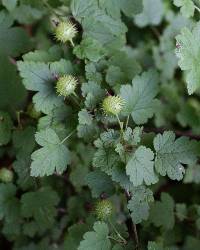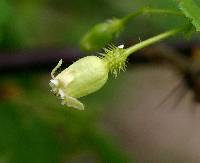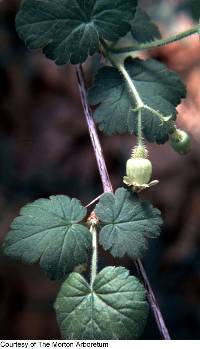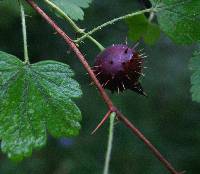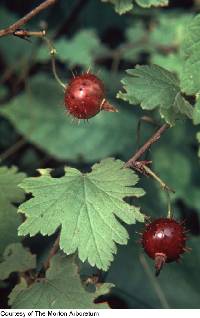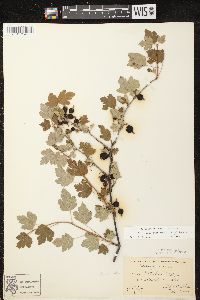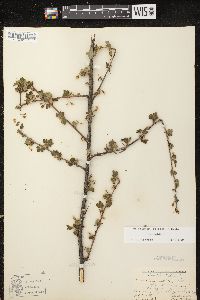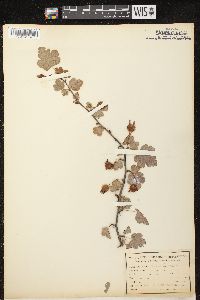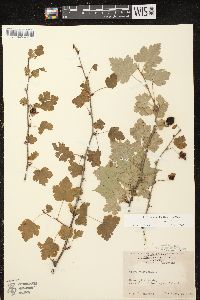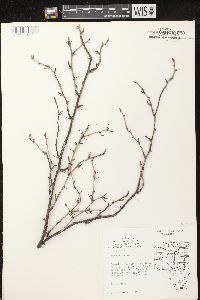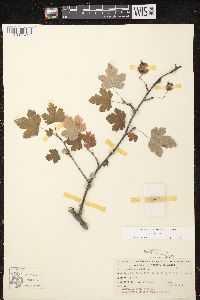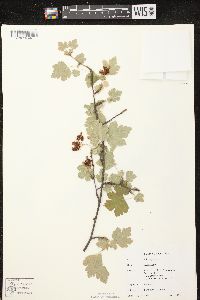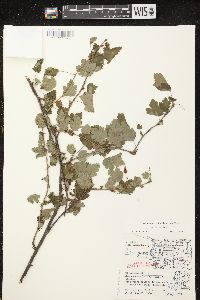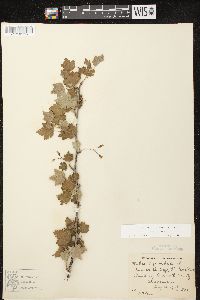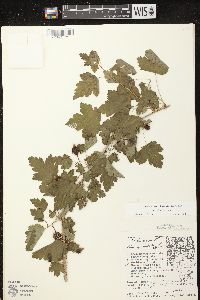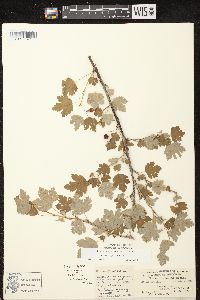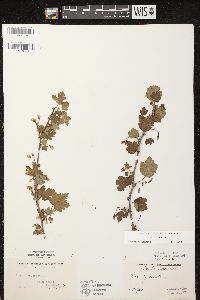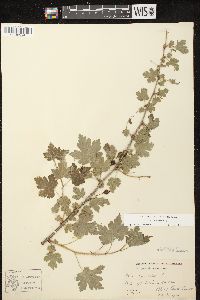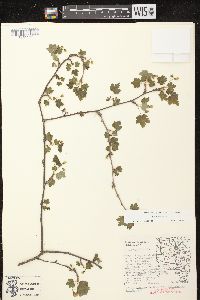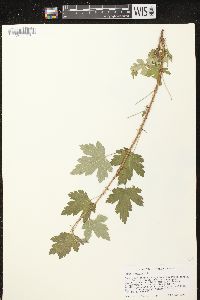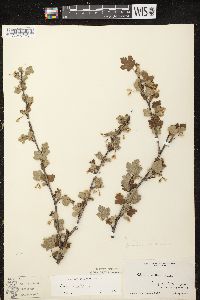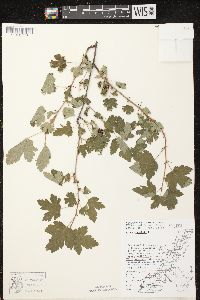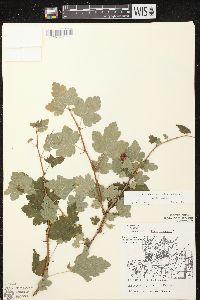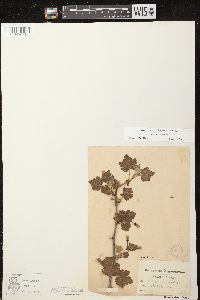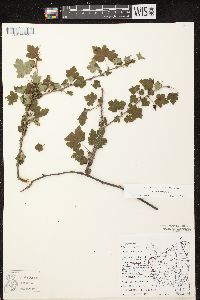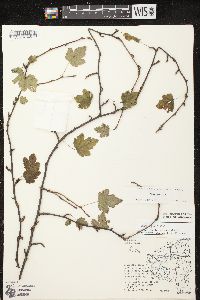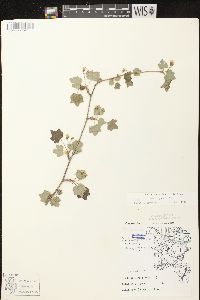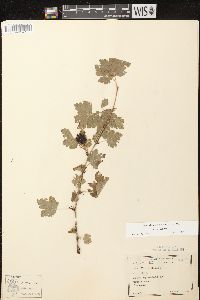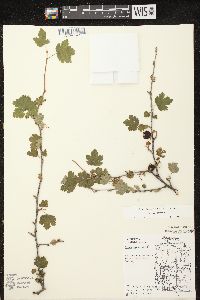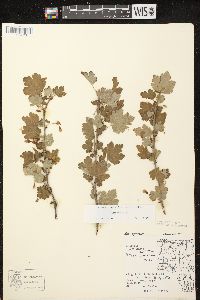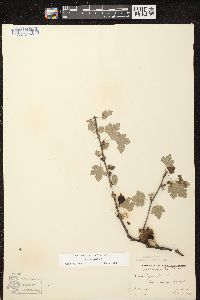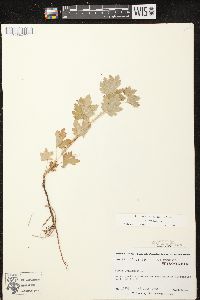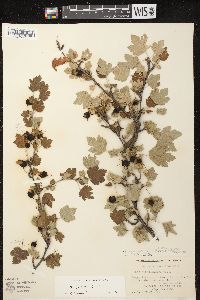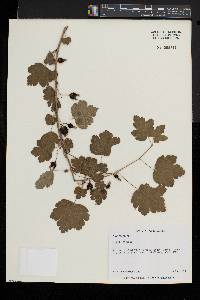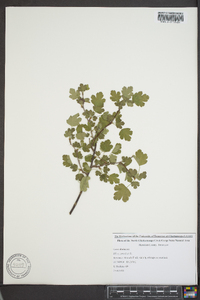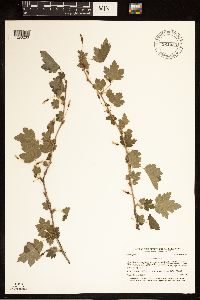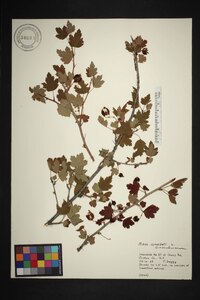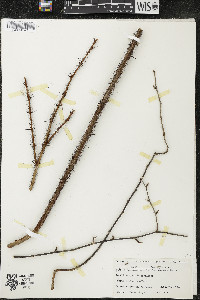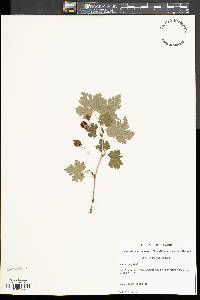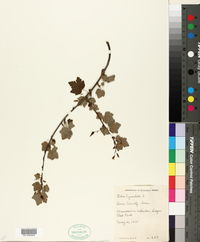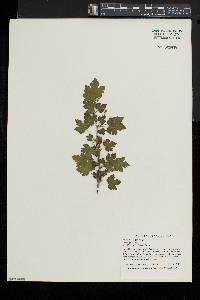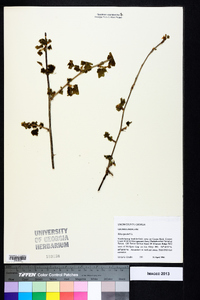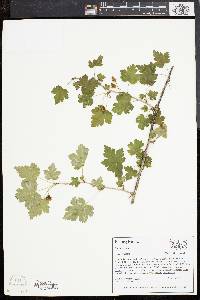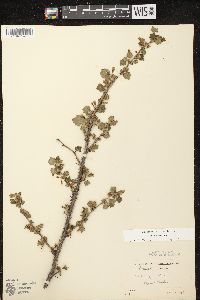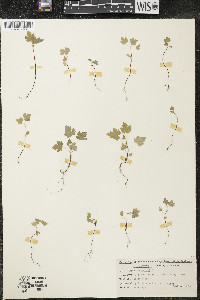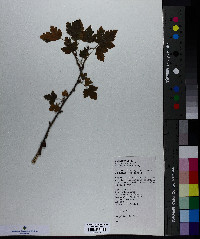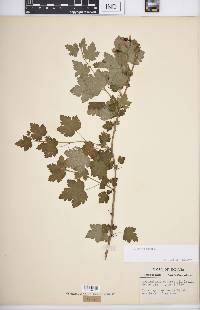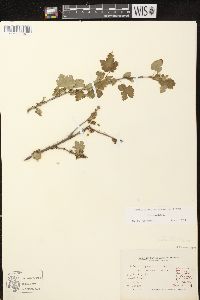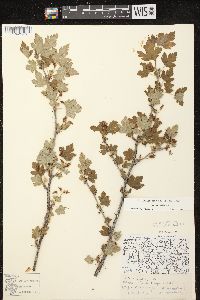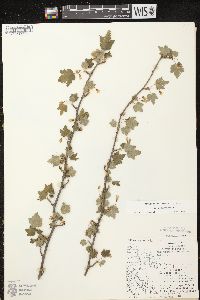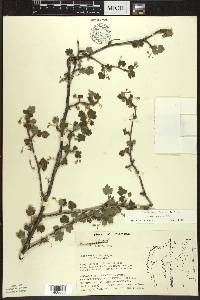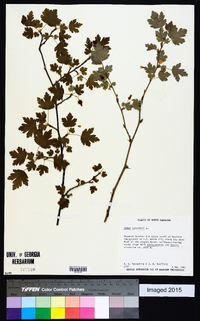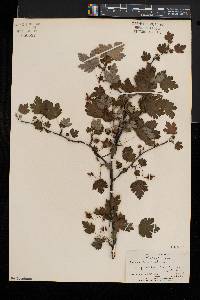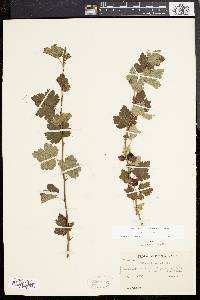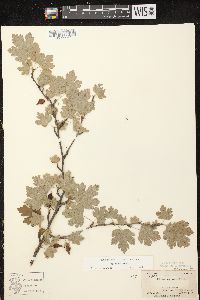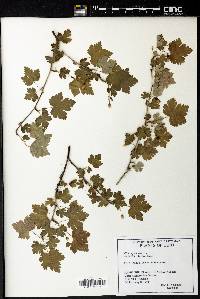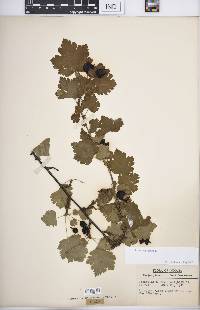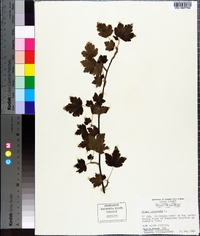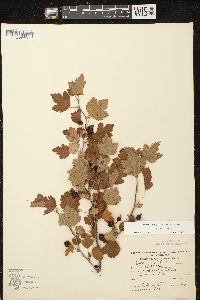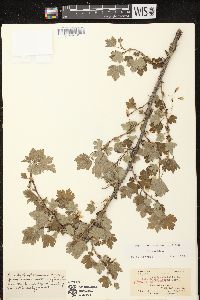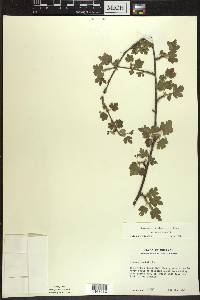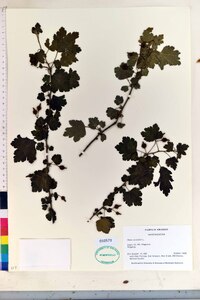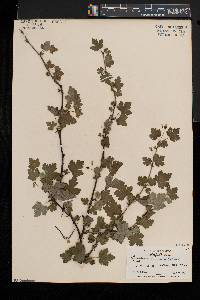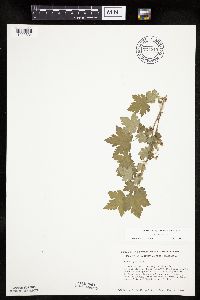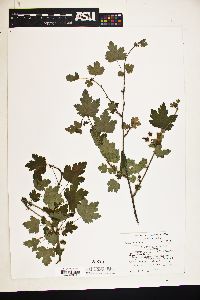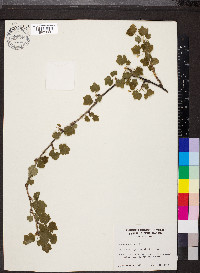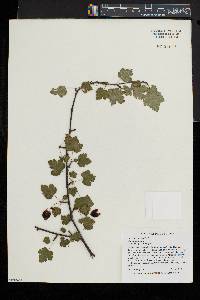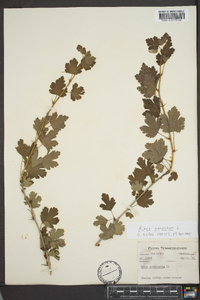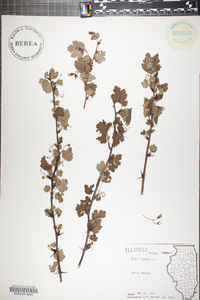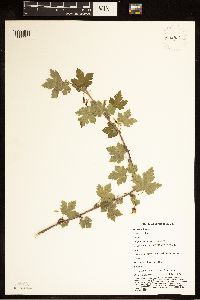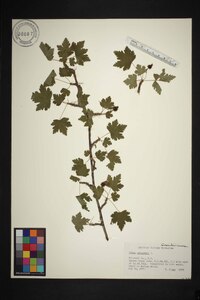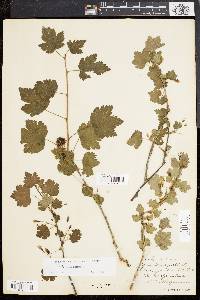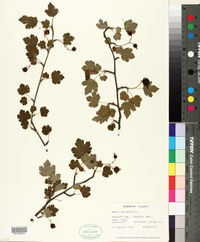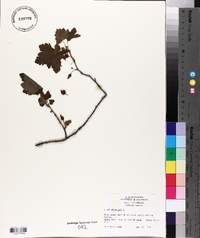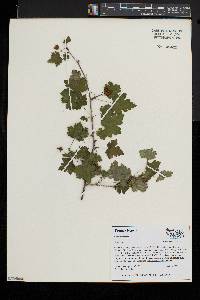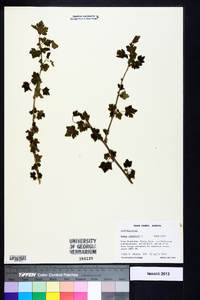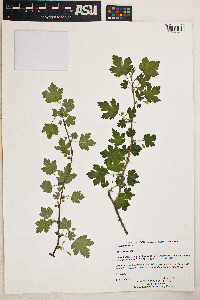Ribes cynosbati
|
|
|
|
Family: Grossulariaceae
Eastern Prickly Gooseberry
[Ribes cynosbati f. inerme Rehder] |
Plants 0.5-1.5 m. Stems erect to spreading, glabrous or pubescent, glabrescent; spines at nodes absent or 1-3, 5-15 mm; prickles on internodes absent or sparse. Leaves: petiole 1-3 cm, pilose and stipitate-glandular; blade pentangular, 3-5-lobed, cleft (1/3-)1/2-3/4 to midrib, 1.7-5 cm, base truncate to cordate, surfaces glabrate or pubescent abaxially, pilose and sometimes with stipitate-glandular hairs adaxially, lobes deltate or cuneate-deltate, margins with rounded teeth, apex rounded or broadly acute. Inflorescences spreading, solitary flowers or 2(-4)-flowered corymbs, 4-5 cm, axis pilose and stipitate-glandular. Pedicels not jointed (sometimes with abcission layer at bract junction), 5-16 mm, glabrous or pilose and stipitate-glandular; bracts lanceolate to ovate, 1.5-2.5 mm, hairy and glandular on margins. Flowers: hypanthium greenish white, campanulate, 1.8-4 mm, glabrous or scattered-hairy; sepals not overlapping, erect to recurved, greenish, oblong, 1.5-4 mm; petals widely separated, erect, white, obovate, not conspicuously revolute or inrolled, 1-2.5 mm; nectary disc not prominent; stamens as long as or slightly longer than petals; filaments linear, 1-2 mm, glabrous; anthers greenish yellow, oval, 0.4-0.6 mm, apex rounded; ovary setose with eglandular or gland-tipped bristles, sometimes sparsely villous; styles connate to middle or 0.8 mm proximal to stigmas, 4.5-7 mm, villous on proximal 1/2 or glabrous. Berries palatable, greenish to pale red, globose, 7-15 mm, densely bristly or spiny. 2n = 16. Flowering May-Jun. Rich hardwoods and conifer-hardwoods, rocky slopes, boulderfields, heath balds; 100-2100 m; N.B., Ont., Que.; Ala., Ark., Conn., Ga., Ill., Ind., Iowa, Ky., Maine, Md., Mass., Mich., Minn., Mo., N.H., N.J., N.Y., N.C., N.Dak., Ohio, Okla., Pa., S.Dak., Tenn., Vt., Va., W.Va., Wis. Low shrub to 1.5 m tall Leaves: alternate, stalked, 2 - 5 cm long and wide, palmately three- to five-lobed, egg-shaped to rounded with a flat to heart-shaped to rounded base, palmately veined, toothed, softly hairy. Stalk 0.5 - 1.6 cm long, hairy, becoming hairless with age. Inflorescence: a single flower or a small, loose cluster (raceme) of up to four flowers, 2 - 6 cm long. Flowers: green. Stalk slender, 1 - 2.5 cm long, and hairy. Stamens five, equaling or slightly longer than the petals, shorter than the calyx. Styles two, undivided. Sepals: forming a five-lobed tube (calyx). Calyx green, bell-shaped. Lobes shorter than the tube. Petals: five, in the throat of the calyx tube, 1 - 2.5 mm long, reverse egg-shaped with a somewhat flat base, alternate with calyx lobes. Fruit: a juicy berry, many-seeded, crowned by the shriveled calyx, reddish purple, 8 - 12 mm wide, spherical to ellipsoid, prickly. Branches: often with slender, 0.5 - 1.5 cm long spines. Nodal spines one to three. Similar species: The similar Ribes hirtellum and R. missouriense differ by having smooth berries and calyx lobes that are as long or longer than the tube. Flowering: mid-April to early June Habitat and ecology: Frequent in mesic woods, especially in the eastern sector of the Chicago Region. Also found in springy areas of the woods. Occurence in the Chicago region: native Etymology: Ribes comes from the Arabic name for a shrub that has acidic fruit. Cynosbati comes from a Greek word meaning dog-berry. Author: The Morton Arboretum Internodes prickly or smooth; nodal spines (0)1-2(3), 5-15 mm; lvs 2-5 cm long and wide, truncate to cordate at base, pubescent, usually not glandular; peduncles 7-25 mm, with 1-3(4) fls on pedicels 5-16 mm, the frs thus held well away from the stems; bracts glandular-ciliate; hypanthium campanulate from a rounded base, 3-4.5 mm (above the ovary); sep broadly oblong, 2.5-4 mm, soon reflexed; pet obovate, subtruncate, 1-2.5 mm; stamens equaling the pet; style equaling the sep, mostly undivided; ovary with stalked glands that become stiff prickles on the greenish to pale red fr; 2n=16. Moist woods; Que. to n. Minn. and e. N.D., s. to n. Ga., sw. Ala., Ark., and e. Okla. May, June. Gleason, Henry A. & Cronquist, Arthur J. 1991. Manual of vascular plants of northeastern United States and adjacent Canada. lxxv + 910 pp. ©The New York Botanical Garden. All rights reserved. Used by permission. From Flora of Indiana (1940) by Charles C. Deam Infrequent to common throughout the state except the southwestern part, from which there are no records or specimens. The species prefers a moist, rich soil and is found generally in woodland. In the southern part of the state, however, it is generally found in the crevices of rocks on rocky, wooded slopes along streams. …… Indiana Coefficient of Conservatism: C = 4 Wetland Indicator Status: FAC |


